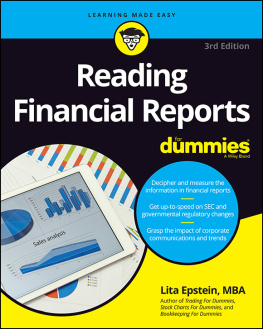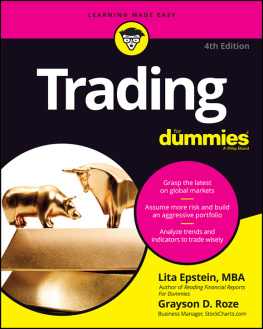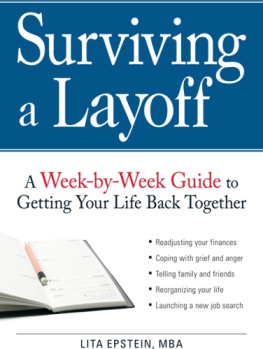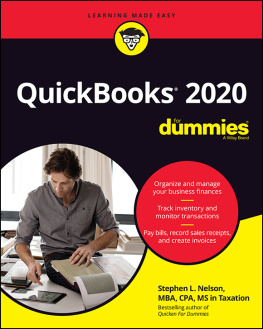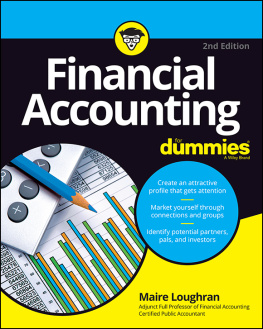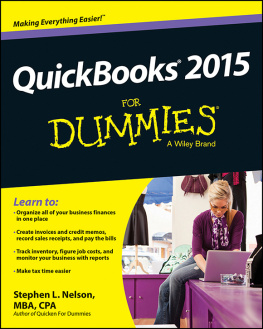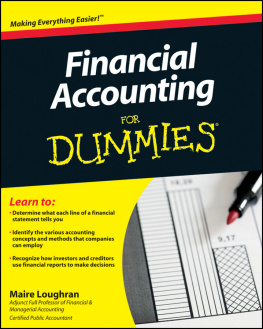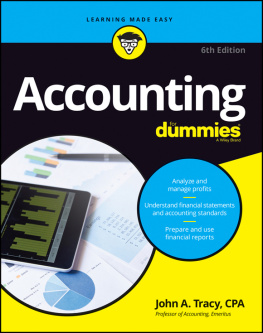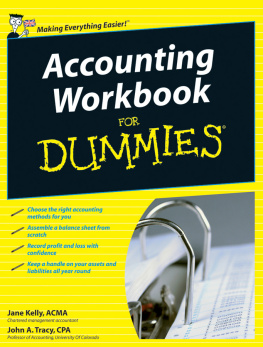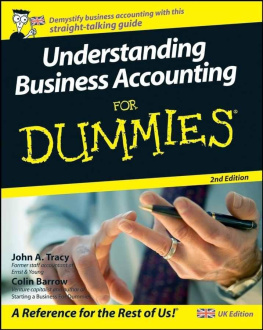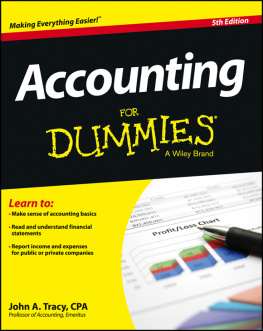
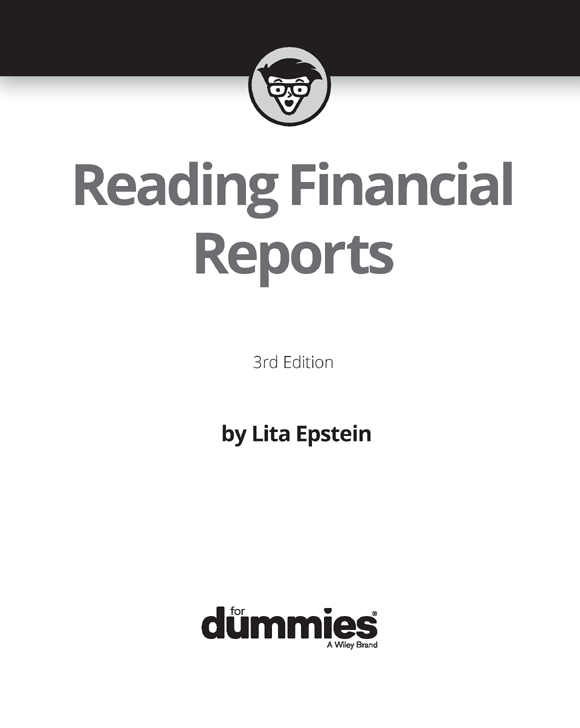
Reading Financial Reports For Dummies, 3rd Edition
Published by: John Wiley & Sons, Inc., 111 River Street, Hoboken, NJ 07030-5774, www.wiley.com
Copyright 2019 by John Wiley & Sons, Inc., Hoboken, New Jersey
Published simultaneously in Canada
No part of this publication may be reproduced, stored in a retrieval system or transmitted in any form or by any means, electronic, mechanical, photocopying, recording, scanning or otherwise, except as permitted under Sections 107 or 108 of the 1976 United States Copyright Act, without the prior written permission of the Publisher. Requests to the Publisher for permission should be addressed to the Permissions Department, John Wiley & Sons, Inc., 111 River Street, Hoboken, NJ 07030, (201) 748-6011, fax (201) 748-6008, or online at http://www.wiley.com/go/permissions .
Trademarks: Wiley, For Dummies, the Dummies Man logo, Dummies.com, Making Everything Easier, and related trade dress are trademarks or registered trademarks of John Wiley & Sons, Inc., and may not be used without written permission. All other trademarks are the property of their respective owners. John Wiley & Sons, Inc., is not associated with any product or vendor mentioned in this book.
LIMIT OF LIABILITY/DISCLAIMER OF WARRANTY: WHILE THE PUBLISHER AND AUTHOR HAVE USED THEIR BEST EFFORTS IN PREPARING THIS BOOK, THEY MAKE NO REPRESENTATIONS OR WARRANTIES WITH RESPECT TO THE ACCURACY OR COMPLETENESS OF THE CONTENTS OF THIS BOOK AND SPECIFICALLY DISCLAIM ANY IMPLIED WARRANTIES OF MERCHANTABILITY OR FITNESS FOR A PARTICULAR PURPOSE. NO WARRANTY MAY BE CREATED OR EXTENDED BY SALES REPRESENTATIVES OR WRITTEN SALES MATERIALS. THE ADVICE AND STRATEGIES CONTAINED HEREIN MAY NOT BE SUITABLE FOR YOUR SITUATION. YOU SHOULD CONSULT WITH A PROFESSIONAL WHERE APPROPRIATE. NEITHER THE PUBLISHER NOR THE AUTHOR SHALL BE LIABLE FOR DAMAGES ARISING HEREFROM.
For general information on our other products and services, please contact our Customer Care Department within the U.S. at 877-762-2974, outside the U.S. at 317-572-3993, or fax 317-572-4002. For technical support, please visit www.wiley.com/techsupport .
Wiley publishes in a variety of print and electronic formats and by print-on-demand. Some material included with standard print versions of this book may not be included in e-books or in print-on-demand. If this book refers to media such as a CD or DVD that is not included in the version you purchased, you may download this material at http://booksupport.wiley.com . For more information about Wiley products, visit www.wiley.com .
Library of Congress Control Number: 2018956058
ISBN 978-1-119-54395-4 (pbk); ISBN 978-1-119-54398-5 (ebk); ISBN 978-1-119-54396-1 (ebk)
Reading Financial Reports For Dummies
To view this book's Cheat Sheet, simply go to www.dummies.com and search for Reading Financial Reports For Dummies Cheat Sheet in the Search box.
Table of Contents
Guide
Pages
Introduction
When I open an annual financial report today, one of the first questions I ask myself is, Can I believe the numbers I'm seeing? I never used to think that way. I used to think that any corporate financial report audited by a certified public accountant truly was prepared with the public's interests in mind.
The financial scandals of the late 1990s and early 2000s destroyed my confidence in those numbers, as they did for millions of other U.S. investors who lost billions in the stock market crash that followed those scandals. Sure, a stock bubble (a period of rising stock prices that stems from a buying frenzy) had burst, but financial reports that hid companies financial problems fueled the bubble and helped companies put on a bright, smiling face for the public. After these financial reporting scandals came to light, more than 500 public companies had to restate their earnings. Yet in almost a repeat of the scandals, the mortgage mess of 2007 showed how financial institutions were still using the same tricks of keeping key financial information off the books to hide financial troubles.
I still wonder what government regulators and public accountants were thinking and doing during these fiascos. How did the system break down so dramatically and so quickly? Although a few voices raised red flags, their pleas were drowned out by the euphoria of the building stock market bubble of the early 1990s and the housing market bubble of the mid-2000s.
These financial scandals occurred partly because Wall Street measures success based on a company's quarterly results. Many analysts on Wall Street are more concerned about whether a company meets its quarterly expectations than they are about a company's long-term prospects for future growth. Companies that fail to meet their quarterly expectations find their stock quickly beaten down on the market. To avoid the fall, companies massage their numbers. This shortsighted race to meet the numbers each quarter is a big reason these scandals happen in the first place.
Since the scandals broke, legislators have enacted new laws and regulations to attempt to correct the problems. In this book, I discuss these new regulations and show you how to read financial reports with an ounce of skepticism and a set of tools that can help you determine whether the numbers make sense. I help you see how companies can play games with their numbers and show you how to analyze the numbers in a financial report so you can determine a company's true financial health.
About This Book
This book provides detailed information on how to read a financial report's key statements the balance sheet, the income statement, and the statement of cash flows as well as how to discover and scour a report's other important parts.
When you finish reading this book, you'll understand what makes up the parts of financial statements and how to read between their lines, using the fine print to increase your understanding of a company's financial position. You'll also be familiar with the company outsiders who are responsible for certifying the accuracy of financial reports, and you'll know how the rules have changed since the corporate scandals broke. Although I can't promise that you'll be able to detect every type of fraud, I can promise that your antennae will be up and you'll be more aware of how to spot possible problems. And most important, you'll get a good understanding of how to use these reports to make informed decisions about whether a company is a sound investment. If you work inside a company, you'll have a better understanding of how to use the reports to manage your company or your department for success.
Conventions Used in This Book
I use the words corporation and company almost interchangeably. Just so we're on the same page, all corporations are companies, but not all companies are corporations. The key difference between them is whether a company has gone through incorporation, which is the rather complicated legal process by which a company gets a state charter to operate as a business. To find out more about company structure and incorporation, see .
To help you practice the tools I show you in this book, I use the annual reports of the two largest toy companies, Mattel and Hasbro, and dissect their reports throughout various chapters. You can download a full copy of the reports by visiting the investor relations section of the companies websites:
Next page
